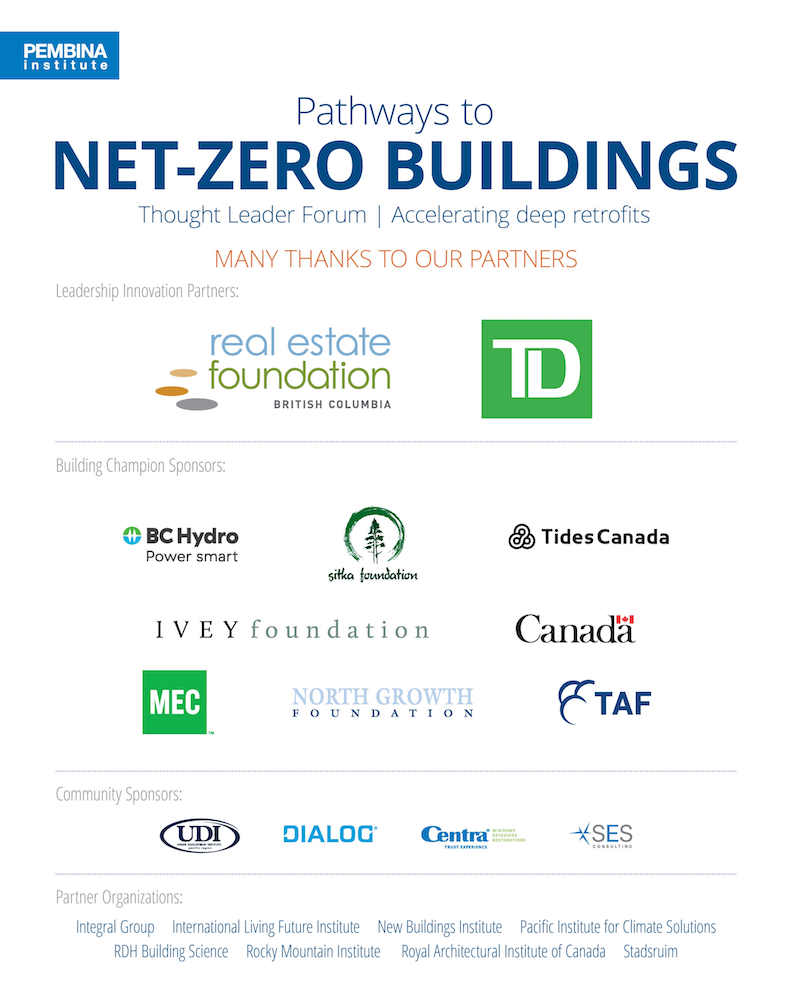(Update: We've posted photos and highlights from the thought leader forum.)
VANCOUVER / COAST SALISH TERRITORY — Buildings constitute the largest source of carbon pollution in North America. Indeed, for Canada to achieve its 2030 climate target and follow through on its long-term decarbonization strategy (released at the Marrakech climate conference), it must significantly reduce the emissions of existing buildings and ensure that new buildings are ultra low carbon.
Next week, leading architects, builders, developers, suppliers, and property managers will come together with officials from the federal, provincial, and local governments to move this important work forward at Pathways to Net-Zero Buildings in Vancouver. With growing momentum behind policies to improve the energy efficiency of new construction, the more than 100 participants at the Pembina Institute’s sold-out thought leader forum will look to identify opportunities to spur the acceleration of deep energy retrofits in existing buildings.
The lineup of speakers includes representatives of Natural Resources Canada, B.C.’s Building and Safety Standards Branch, The Atmospheric Fund of Ontario, the cities of Vancouver and Seattle, and the U.S.-based Rocky Mountain Institute and MEETS Accelerator Coalition. The forum is made possible by the support of the Real Estate Foundation of British Columbia and TD Bank Group, sponsors, and partner organizations.
Pembina Institute spokespeople are available for interviews this week and next week.
Pathways to Net-Zero Buildings
Date: November 28 to 29, 2016
Location: Sandman Hotel Vancouver City Centre (180 West Georgia Street, Vancouver)
Interviews:
- Karen Tam Wu, director of the buildings and urban solutions program, Pembina Institute (English)
- Tom-Pierre Frappé-Sénéclauze, senior advisor, Pembina Institute (English / français)
Quick facts
- Buildings are responsible for nearly one-quarter of Canada’s carbon pollution.
- Net-zero energy ready buildings are so efficient that their annual energy demand could be offset by on-site renewable energy, such as solar panels.
- More than 10,000 green homes and buildings are located in B.C.
[30]
Download the backgrounder: Building Energy Retrofit Potential in B.C.
Learn more about Pathways to Net-Zero Buildings: pembina.org/netzeroforum
Find photos for editorial use: flickr.com/pembina
Join the conversation on Twitter: #NetZeroForum @Pembina
Contact
Stephen Hui
Communications Lead, Pembina Institute
778-987-7654
stephenh@pembina.org
Tw: @StephenHui
Background
Report: Accelerating Market Transformation for High-Performance Building Enclosures
Blog: Taking green buildings to the next level in B.C.
Op-ed: A blueprint for quality buildings and green jobs for B.C. and beyond
Op-ed: Beyond carbon: The true value of energy-efficient buildings
About the Pembina Institute
The Pembina Institute is a non-profit think-tank that advocates for strong, effective policies to support Canada’s clean-energy transition. We have offices in Calgary, Edmonton, Toronto, and Vancouver. Learn more: www.pembina.org





